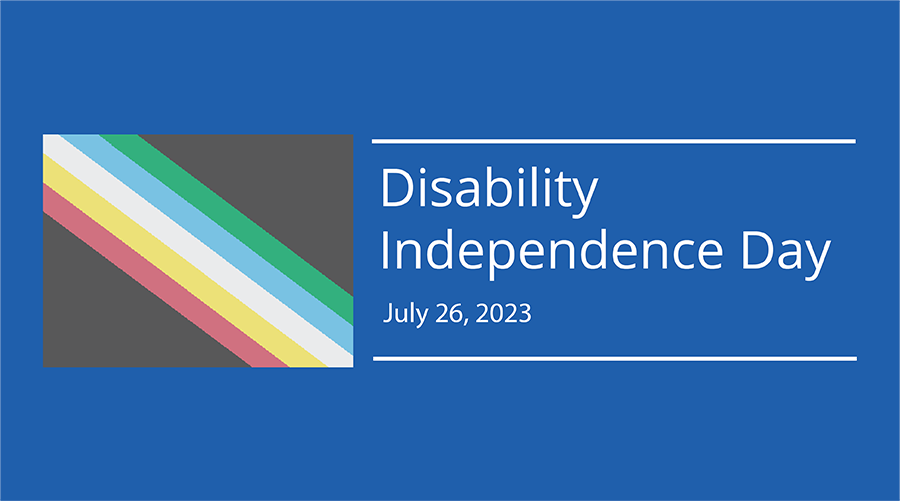
The Disability Pride Flag (above) was designed by Ann Magill. The charcoal gray background commemorates and mourns disabled people who have died due to ableism, violence, negligence, suicide, rebellion, illness and eugenics. The stripes represent different disabilities: green is for sensory disabilities, including the blind, deaf, and deaf-blind communities; blue represents psychiatric disabilities; white stands for non-apparent and undiagnosed disabilities; gold is for neurodivergence; and red represents physical disabilities. Visit our Disability Pride page for a full description of the flag.
About Disability Independence Day
Following a few weeks after Independence Day, July 26 is recognized annually as National Disability Independence Day, commemorating the 33rd anniversary of the Americans with Disabilities Act (ADA) being signed into law in 1990 by President George H.W. Bush, prohibiting discrimination against those with disabilities.
Although we’ve come a long way since this law was passed, there is still a lot of work to do. Before the ADA, stigma was acute for all types of disabilities. For example, common views included: disabled people are fragile; people with disabilities can’t work; and disabled people can’t overcome adversity. But the reality is, in 2023, stigmas remain prevalent and tremendous barriers continue to exist.
In the United States, currently one in four people live with some form of disability; around the world, one billion people do. While some disabilities are apparent, others are less apparent. Disability impacts all of us at some point in our lives. You might have a disability or know someone that has a disability, or you or someone you know may gain a disability later in life. Essentially, disability is a part of all of our experiences. Let’s do our part in improving the way to full equity and access, and commit to building a more authentic and inclusive society.
Everyone has a part to play. How can we do our part?
As referenced in a recent Forbes article on June 28, 2023, Celebrating Disability Pride Month – What's Your Role? by Keely Cat-Wells, below are some things you can do to make this world a more inclusive place:
Companies
- Inclusive Hiring Practices: Disabled people should be hired for all roles, not just those specifically related to disability. This expands the scope of opportunities and allows disabled individuals to bring their diverse perspectives to various aspects of the organization.
- Appoint Access Coordinators: For every project, an Access Coordinator should be assigned to ensure that accessibility requirements are met. This role will involve planning, implementing, and monitoring accessibility measures, enabling the project to be inclusive from the outset.
- Discard Assumptions: It's crucial not to assume what someone can or cannot do or what they may or may not need. Disabilities can be non-apparent, and people’s access requirements can vary greatly. Encourage open conversations and avoid making assumptions about what someone can or cannot do based on their appearance.
- Prioritize Disability in your Diversity Agenda: While diversity agendas often focus on aspects like race, gender, and sexual orientation, it's crucial that disability is included too. This ensures that the unique challenges faced by disabled individuals are recognized and addressed.
Allys
- Self-Education: Begin by educating yourself about the realities faced by the disabled community. A good starting point can be as simple as following hashtags on social media such as #DisabilityRights, #SpoonieCommunity, #A11y, #Accessibility, #RightsOnFlights, #IStayStrong, #DisabledAndCute. These hashtags offer a window into the experiences, concerns, and triumphs of disabled individuals, and they'll allow you to gain insights into the everyday barriers that the community faces. Understanding is the first step toward empathy and effective allyship.
- Amplify Disabled Voices: Practice 'passing the mic' by giving disabled people a platform to share their experiences, knowledge, and perspectives, and pay them for their time and expertise. This could mean inviting disabled speakers to events, featuring disabled writers in publications, or sharing content created by disabled people on your social media. Amplifying disabled voices fosters representation and allows these critical perspectives to reach a wider audience.
- Prioritize Accessibility: Ensure that all spaces, physical or virtual, are accessible. This includes everything from: installing ramps and lifts in buildings, providing sign language interpretation, closed captioning and transcripts for all content, ensuring that websites are navigable with screen readers, avoiding plug-ins or overlays and going beyond the basic compliance. Promote and participate in the design of accessible environments in your community, workplace, and social circles.
Understanding Disability Culture and the Disability Rights Movement
Here is a brief timeline of some historical milestones. Note that it does not provide a comprehensive history of the disability rights movement in America as there have been so many historical moments (both good and bad) that have shaped disability culture and identity within the United States.
Note: This communication uses both identity-first (disabled person) and person-first language (person with a disability) to align with the APA Style Guide on Disability. The content provided from Keely Cat-Wells's article is all in identity-first as that is how Keely wrote the content.
Communication developed by Chanda Wolf.
